HR Skills, SWOT Analysis and Development for Tesco Organization
VerifiedAdded on 2020/12/29
|16
|4671
|418
Report
AI Summary
This report provides a comprehensive analysis of the skills and attributes required by HR professionals, including self-discipline, time management, decision-making, and communication. It includes a SWOT analysis for an HR professional, outlining strengths, weaknesses, opportunities, and threats, followed by a development plan to address identified weaknesses and leverage opportunities. The report further introduces Tesco, a British multinational retailer, and discusses the importance of continuous professional development (CPD) and high-performance working (HPW) in enhancing employee engagement. Different approaches to HPW are also examined, providing a holistic view of HR practices and organizational development.
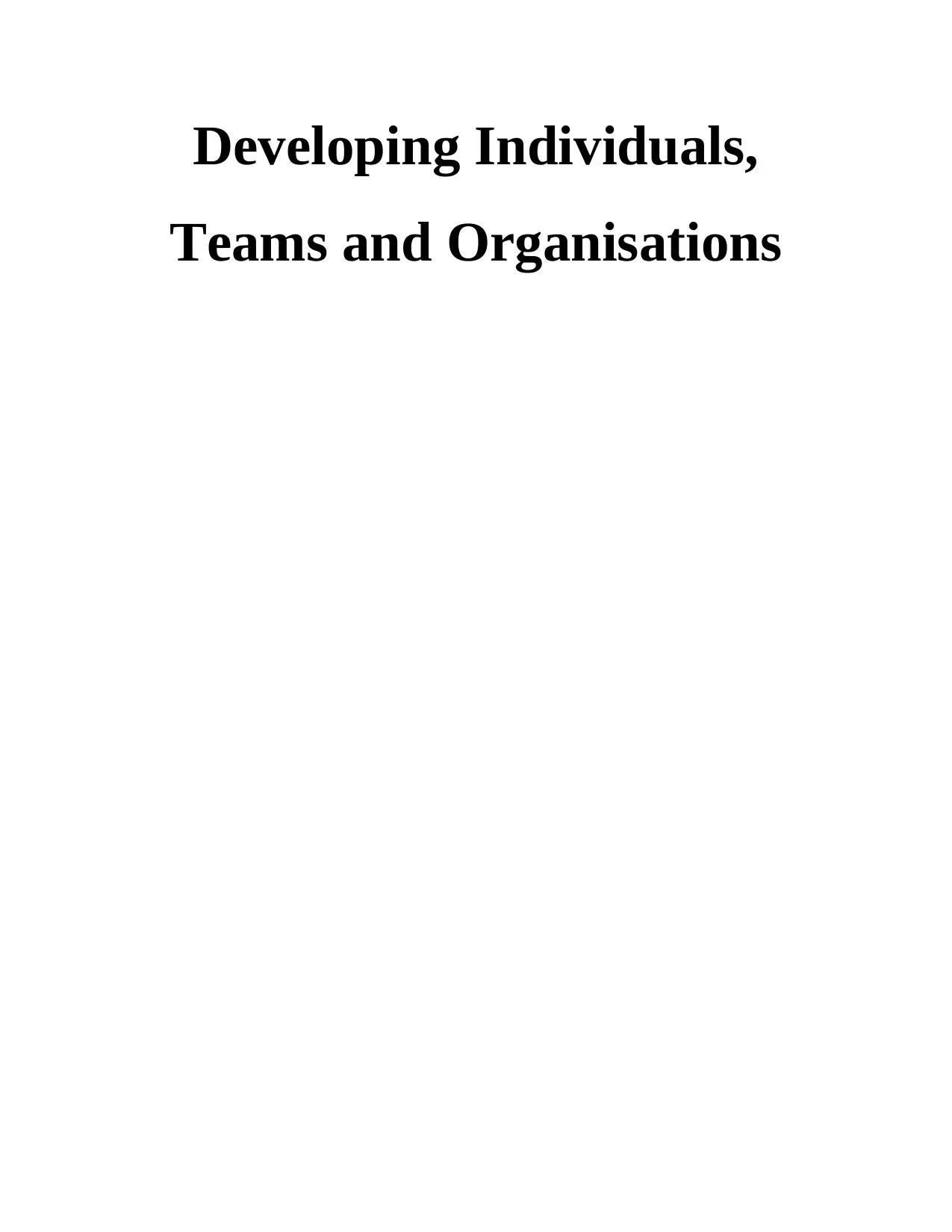
Developing Individuals,
Teams and Organisations
Teams and Organisations
Paraphrase This Document
Need a fresh take? Get an instant paraphrase of this document with our AI Paraphraser
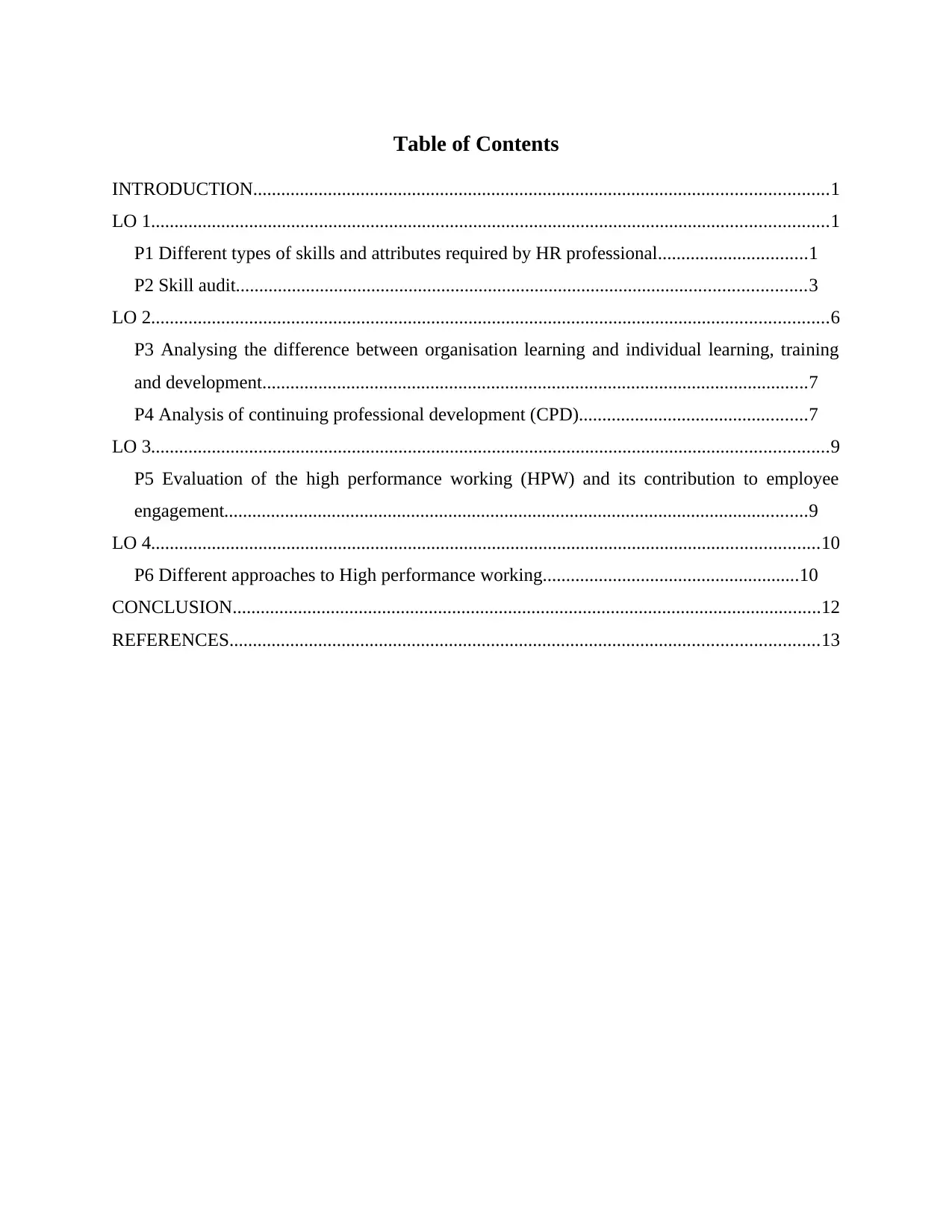
Table of Contents
INTRODUCTION...........................................................................................................................1
LO 1.................................................................................................................................................1
P1 Different types of skills and attributes required by HR professional................................1
P2 Skill audit..........................................................................................................................3
LO 2.................................................................................................................................................6
P3 Analysing the difference between organisation learning and individual learning, training
and development.....................................................................................................................7
P4 Analysis of continuing professional development (CPD).................................................7
LO 3.................................................................................................................................................9
P5 Evaluation of the high performance working (HPW) and its contribution to employee
engagement.............................................................................................................................9
LO 4...............................................................................................................................................10
P6 Different approaches to High performance working.......................................................10
CONCLUSION..............................................................................................................................12
REFERENCES..............................................................................................................................13
INTRODUCTION...........................................................................................................................1
LO 1.................................................................................................................................................1
P1 Different types of skills and attributes required by HR professional................................1
P2 Skill audit..........................................................................................................................3
LO 2.................................................................................................................................................6
P3 Analysing the difference between organisation learning and individual learning, training
and development.....................................................................................................................7
P4 Analysis of continuing professional development (CPD).................................................7
LO 3.................................................................................................................................................9
P5 Evaluation of the high performance working (HPW) and its contribution to employee
engagement.............................................................................................................................9
LO 4...............................................................................................................................................10
P6 Different approaches to High performance working.......................................................10
CONCLUSION..............................................................................................................................12
REFERENCES..............................................................................................................................13

⊘ This is a preview!⊘
Do you want full access?
Subscribe today to unlock all pages.

Trusted by 1+ million students worldwide
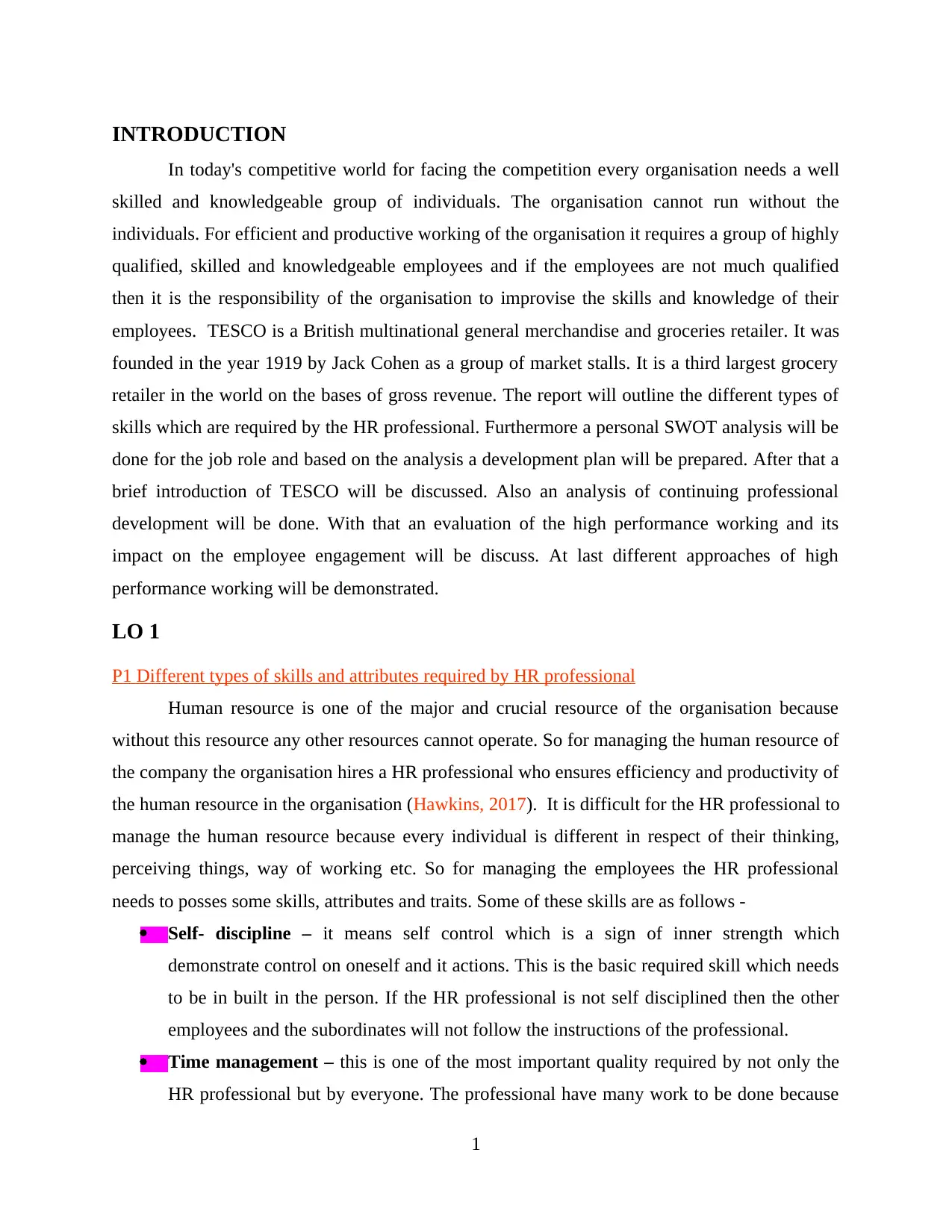
INTRODUCTION
In today's competitive world for facing the competition every organisation needs a well
skilled and knowledgeable group of individuals. The organisation cannot run without the
individuals. For efficient and productive working of the organisation it requires a group of highly
qualified, skilled and knowledgeable employees and if the employees are not much qualified
then it is the responsibility of the organisation to improvise the skills and knowledge of their
employees. TESCO is a British multinational general merchandise and groceries retailer. It was
founded in the year 1919 by Jack Cohen as a group of market stalls. It is a third largest grocery
retailer in the world on the bases of gross revenue. The report will outline the different types of
skills which are required by the HR professional. Furthermore a personal SWOT analysis will be
done for the job role and based on the analysis a development plan will be prepared. After that a
brief introduction of TESCO will be discussed. Also an analysis of continuing professional
development will be done. With that an evaluation of the high performance working and its
impact on the employee engagement will be discuss. At last different approaches of high
performance working will be demonstrated.
LO 1
P1 Different types of skills and attributes required by HR professional
Human resource is one of the major and crucial resource of the organisation because
without this resource any other resources cannot operate. So for managing the human resource of
the company the organisation hires a HR professional who ensures efficiency and productivity of
the human resource in the organisation (Hawkins, 2017). It is difficult for the HR professional to
manage the human resource because every individual is different in respect of their thinking,
perceiving things, way of working etc. So for managing the employees the HR professional
needs to posses some skills, attributes and traits. Some of these skills are as follows -
Self- discipline – it means self control which is a sign of inner strength which
demonstrate control on oneself and it actions. This is the basic required skill which needs
to be in built in the person. If the HR professional is not self disciplined then the other
employees and the subordinates will not follow the instructions of the professional.
Time management – this is one of the most important quality required by not only the
HR professional but by everyone. The professional have many work to be done because
1
In today's competitive world for facing the competition every organisation needs a well
skilled and knowledgeable group of individuals. The organisation cannot run without the
individuals. For efficient and productive working of the organisation it requires a group of highly
qualified, skilled and knowledgeable employees and if the employees are not much qualified
then it is the responsibility of the organisation to improvise the skills and knowledge of their
employees. TESCO is a British multinational general merchandise and groceries retailer. It was
founded in the year 1919 by Jack Cohen as a group of market stalls. It is a third largest grocery
retailer in the world on the bases of gross revenue. The report will outline the different types of
skills which are required by the HR professional. Furthermore a personal SWOT analysis will be
done for the job role and based on the analysis a development plan will be prepared. After that a
brief introduction of TESCO will be discussed. Also an analysis of continuing professional
development will be done. With that an evaluation of the high performance working and its
impact on the employee engagement will be discuss. At last different approaches of high
performance working will be demonstrated.
LO 1
P1 Different types of skills and attributes required by HR professional
Human resource is one of the major and crucial resource of the organisation because
without this resource any other resources cannot operate. So for managing the human resource of
the company the organisation hires a HR professional who ensures efficiency and productivity of
the human resource in the organisation (Hawkins, 2017). It is difficult for the HR professional to
manage the human resource because every individual is different in respect of their thinking,
perceiving things, way of working etc. So for managing the employees the HR professional
needs to posses some skills, attributes and traits. Some of these skills are as follows -
Self- discipline – it means self control which is a sign of inner strength which
demonstrate control on oneself and it actions. This is the basic required skill which needs
to be in built in the person. If the HR professional is not self disciplined then the other
employees and the subordinates will not follow the instructions of the professional.
Time management – this is one of the most important quality required by not only the
HR professional but by everyone. The professional have many work to be done because
1
Paraphrase This Document
Need a fresh take? Get an instant paraphrase of this document with our AI Paraphraser
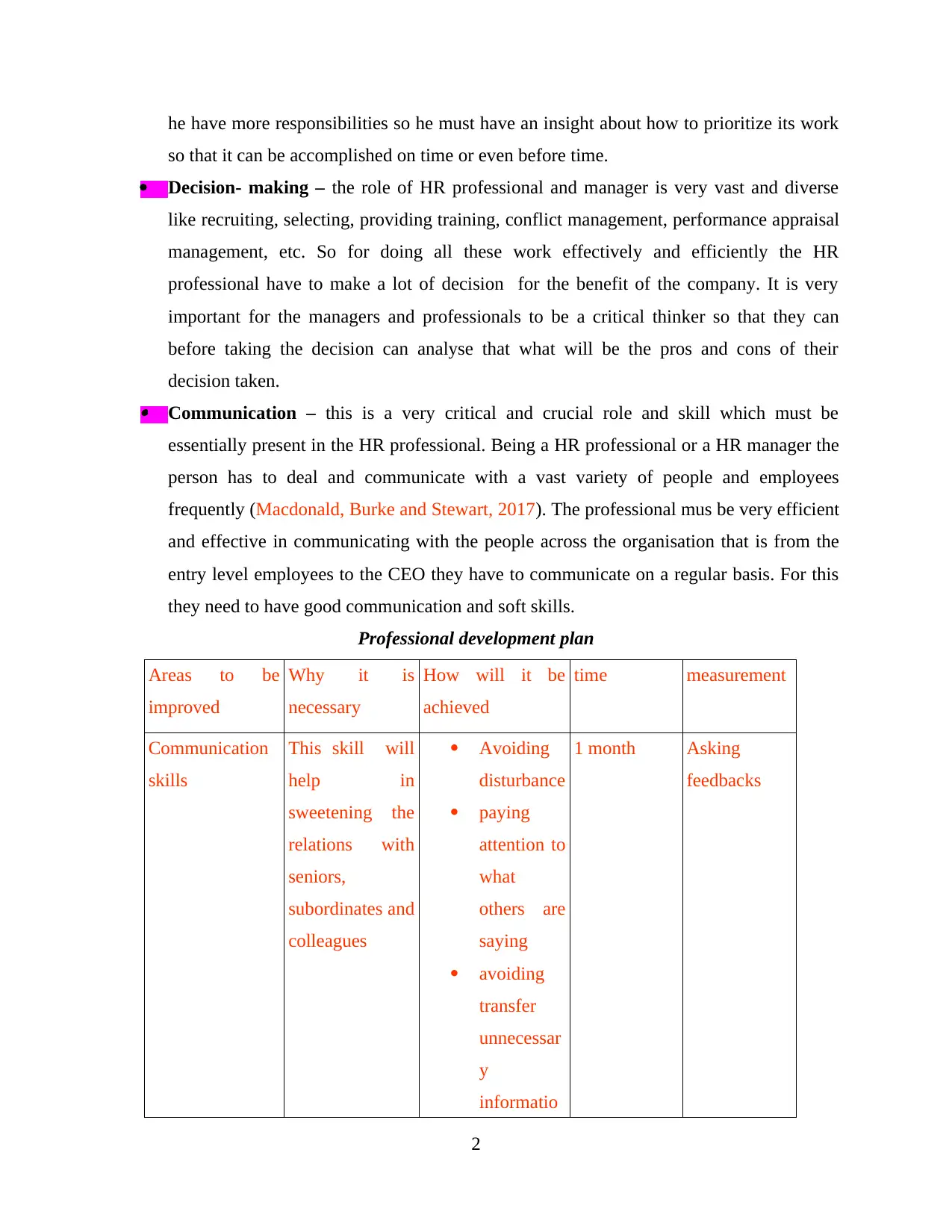
he have more responsibilities so he must have an insight about how to prioritize its work
so that it can be accomplished on time or even before time.
Decision- making – the role of HR professional and manager is very vast and diverse
like recruiting, selecting, providing training, conflict management, performance appraisal
management, etc. So for doing all these work effectively and efficiently the HR
professional have to make a lot of decision for the benefit of the company. It is very
important for the managers and professionals to be a critical thinker so that they can
before taking the decision can analyse that what will be the pros and cons of their
decision taken. Communication – this is a very critical and crucial role and skill which must be
essentially present in the HR professional. Being a HR professional or a HR manager the
person has to deal and communicate with a vast variety of people and employees
frequently (Macdonald, Burke and Stewart, 2017). The professional mus be very efficient
and effective in communicating with the people across the organisation that is from the
entry level employees to the CEO they have to communicate on a regular basis. For this
they need to have good communication and soft skills.
Professional development plan
Areas to be
improved
Why it is
necessary
How will it be
achieved
time measurement
Communication
skills
This skill will
help in
sweetening the
relations with
seniors,
subordinates and
colleagues
Avoiding
disturbance
paying
attention to
what
others are
saying
avoiding
transfer
unnecessar
y
informatio
1 month Asking
feedbacks
2
so that it can be accomplished on time or even before time.
Decision- making – the role of HR professional and manager is very vast and diverse
like recruiting, selecting, providing training, conflict management, performance appraisal
management, etc. So for doing all these work effectively and efficiently the HR
professional have to make a lot of decision for the benefit of the company. It is very
important for the managers and professionals to be a critical thinker so that they can
before taking the decision can analyse that what will be the pros and cons of their
decision taken. Communication – this is a very critical and crucial role and skill which must be
essentially present in the HR professional. Being a HR professional or a HR manager the
person has to deal and communicate with a vast variety of people and employees
frequently (Macdonald, Burke and Stewart, 2017). The professional mus be very efficient
and effective in communicating with the people across the organisation that is from the
entry level employees to the CEO they have to communicate on a regular basis. For this
they need to have good communication and soft skills.
Professional development plan
Areas to be
improved
Why it is
necessary
How will it be
achieved
time measurement
Communication
skills
This skill will
help in
sweetening the
relations with
seniors,
subordinates and
colleagues
Avoiding
disturbance
paying
attention to
what
others are
saying
avoiding
transfer
unnecessar
y
informatio
1 month Asking
feedbacks
2
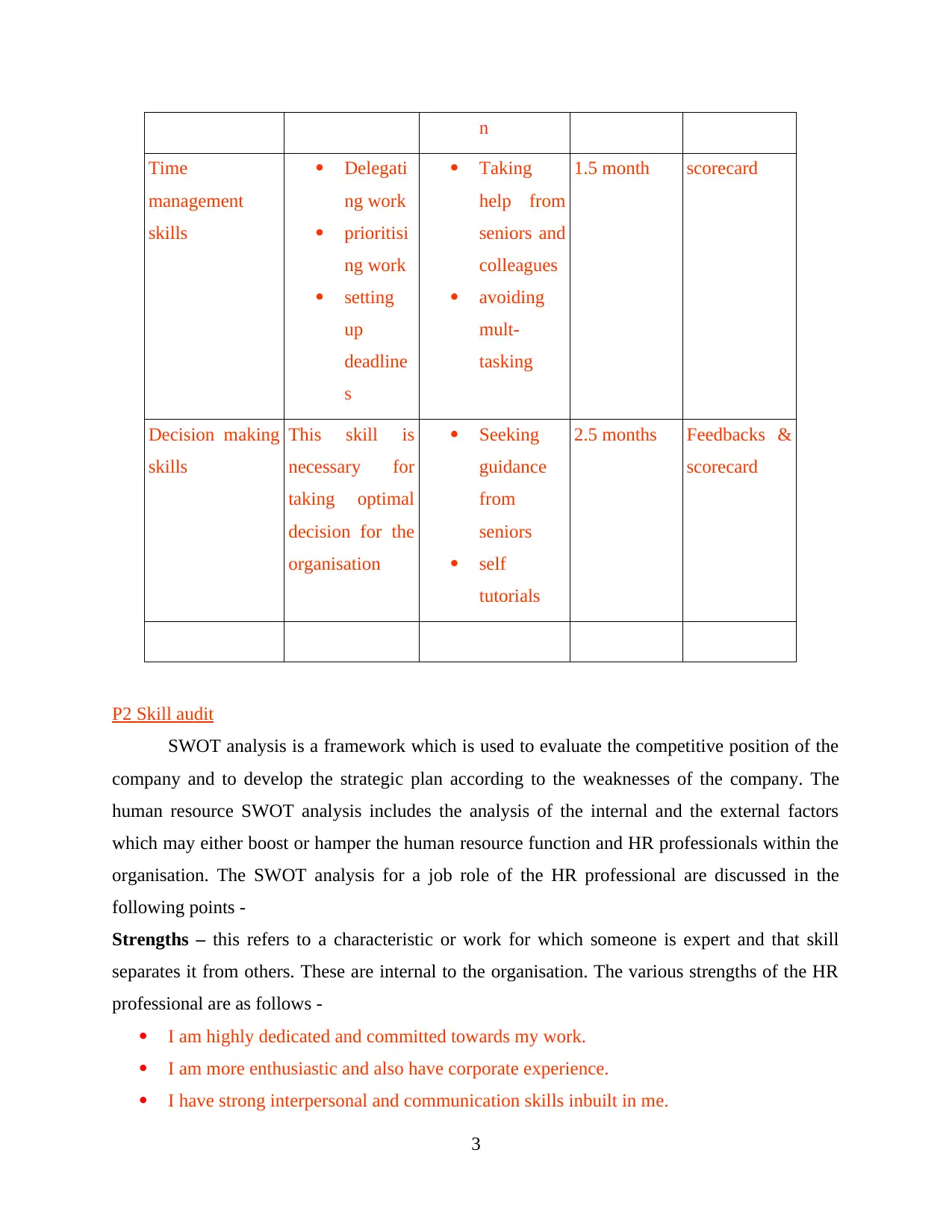
n
Time
management
skills
Delegati
ng work
prioritisi
ng work
setting
up
deadline
s
Taking
help from
seniors and
colleagues
avoiding
mult-
tasking
1.5 month scorecard
Decision making
skills
This skill is
necessary for
taking optimal
decision for the
organisation
Seeking
guidance
from
seniors
self
tutorials
2.5 months Feedbacks &
scorecard
P2 Skill audit
SWOT analysis is a framework which is used to evaluate the competitive position of the
company and to develop the strategic plan according to the weaknesses of the company. The
human resource SWOT analysis includes the analysis of the internal and the external factors
which may either boost or hamper the human resource function and HR professionals within the
organisation. The SWOT analysis for a job role of the HR professional are discussed in the
following points -
Strengths – this refers to a characteristic or work for which someone is expert and that skill
separates it from others. These are internal to the organisation. The various strengths of the HR
professional are as follows -
I am highly dedicated and committed towards my work.
I am more enthusiastic and also have corporate experience.
I have strong interpersonal and communication skills inbuilt in me.
3
Time
management
skills
Delegati
ng work
prioritisi
ng work
setting
up
deadline
s
Taking
help from
seniors and
colleagues
avoiding
mult-
tasking
1.5 month scorecard
Decision making
skills
This skill is
necessary for
taking optimal
decision for the
organisation
Seeking
guidance
from
seniors
self
tutorials
2.5 months Feedbacks &
scorecard
P2 Skill audit
SWOT analysis is a framework which is used to evaluate the competitive position of the
company and to develop the strategic plan according to the weaknesses of the company. The
human resource SWOT analysis includes the analysis of the internal and the external factors
which may either boost or hamper the human resource function and HR professionals within the
organisation. The SWOT analysis for a job role of the HR professional are discussed in the
following points -
Strengths – this refers to a characteristic or work for which someone is expert and that skill
separates it from others. These are internal to the organisation. The various strengths of the HR
professional are as follows -
I am highly dedicated and committed towards my work.
I am more enthusiastic and also have corporate experience.
I have strong interpersonal and communication skills inbuilt in me.
3
⊘ This is a preview!⊘
Do you want full access?
Subscribe today to unlock all pages.

Trusted by 1+ million students worldwide
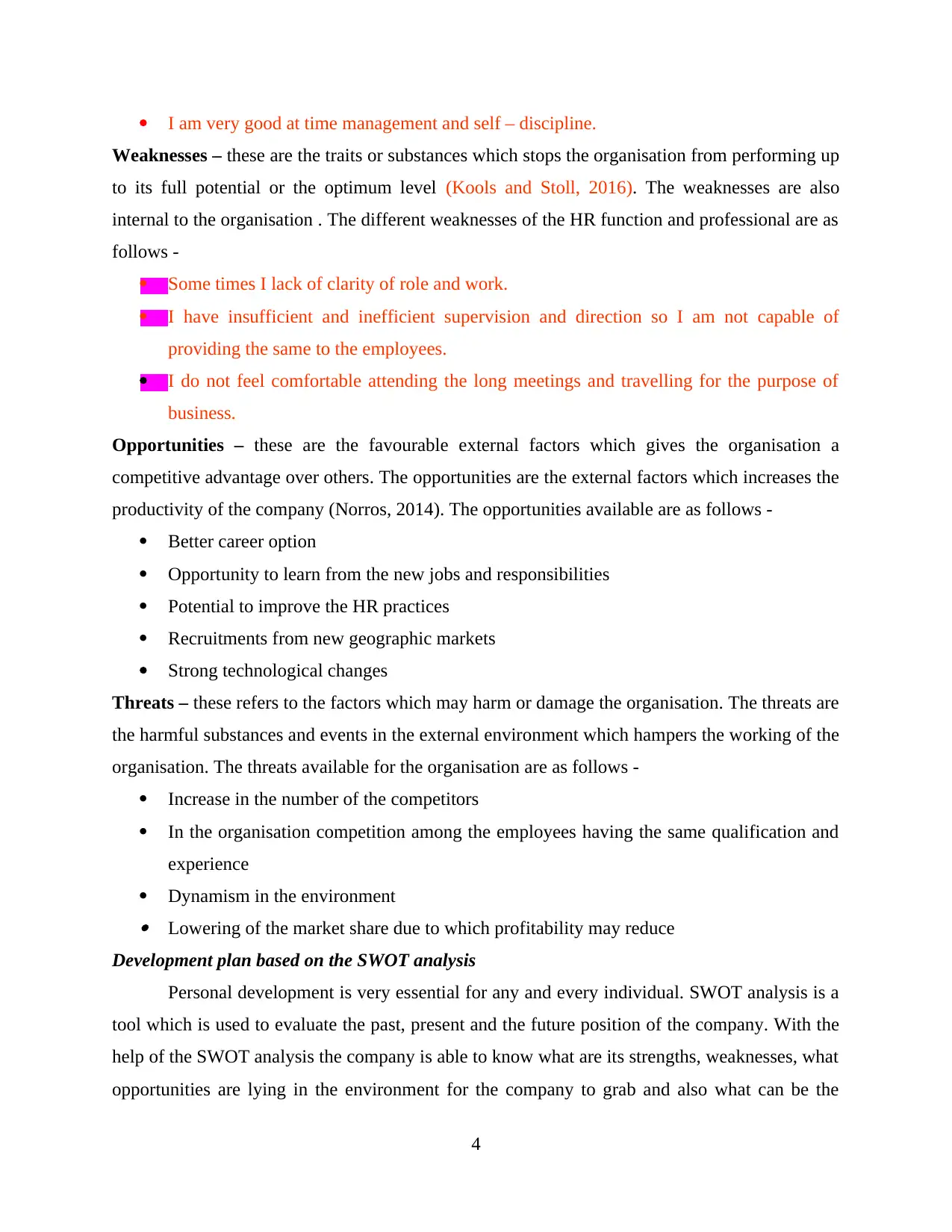
I am very good at time management and self – discipline.
Weaknesses – these are the traits or substances which stops the organisation from performing up
to its full potential or the optimum level (Kools and Stoll, 2016). The weaknesses are also
internal to the organisation . The different weaknesses of the HR function and professional are as
follows -
Some times I lack of clarity of role and work.
I have insufficient and inefficient supervision and direction so I am not capable of
providing the same to the employees.
I do not feel comfortable attending the long meetings and travelling for the purpose of
business.
Opportunities – these are the favourable external factors which gives the organisation a
competitive advantage over others. The opportunities are the external factors which increases the
productivity of the company (Norros, 2014). The opportunities available are as follows -
Better career option
Opportunity to learn from the new jobs and responsibilities
Potential to improve the HR practices
Recruitments from new geographic markets
Strong technological changes
Threats – these refers to the factors which may harm or damage the organisation. The threats are
the harmful substances and events in the external environment which hampers the working of the
organisation. The threats available for the organisation are as follows -
Increase in the number of the competitors
In the organisation competition among the employees having the same qualification and
experience
Dynamism in the environment Lowering of the market share due to which profitability may reduce
Development plan based on the SWOT analysis
Personal development is very essential for any and every individual. SWOT analysis is a
tool which is used to evaluate the past, present and the future position of the company. With the
help of the SWOT analysis the company is able to know what are its strengths, weaknesses, what
opportunities are lying in the environment for the company to grab and also what can be the
4
Weaknesses – these are the traits or substances which stops the organisation from performing up
to its full potential or the optimum level (Kools and Stoll, 2016). The weaknesses are also
internal to the organisation . The different weaknesses of the HR function and professional are as
follows -
Some times I lack of clarity of role and work.
I have insufficient and inefficient supervision and direction so I am not capable of
providing the same to the employees.
I do not feel comfortable attending the long meetings and travelling for the purpose of
business.
Opportunities – these are the favourable external factors which gives the organisation a
competitive advantage over others. The opportunities are the external factors which increases the
productivity of the company (Norros, 2014). The opportunities available are as follows -
Better career option
Opportunity to learn from the new jobs and responsibilities
Potential to improve the HR practices
Recruitments from new geographic markets
Strong technological changes
Threats – these refers to the factors which may harm or damage the organisation. The threats are
the harmful substances and events in the external environment which hampers the working of the
organisation. The threats available for the organisation are as follows -
Increase in the number of the competitors
In the organisation competition among the employees having the same qualification and
experience
Dynamism in the environment Lowering of the market share due to which profitability may reduce
Development plan based on the SWOT analysis
Personal development is very essential for any and every individual. SWOT analysis is a
tool which is used to evaluate the past, present and the future position of the company. With the
help of the SWOT analysis the company is able to know what are its strengths, weaknesses, what
opportunities are lying in the environment for the company to grab and also what can be the
4
Paraphrase This Document
Need a fresh take? Get an instant paraphrase of this document with our AI Paraphraser
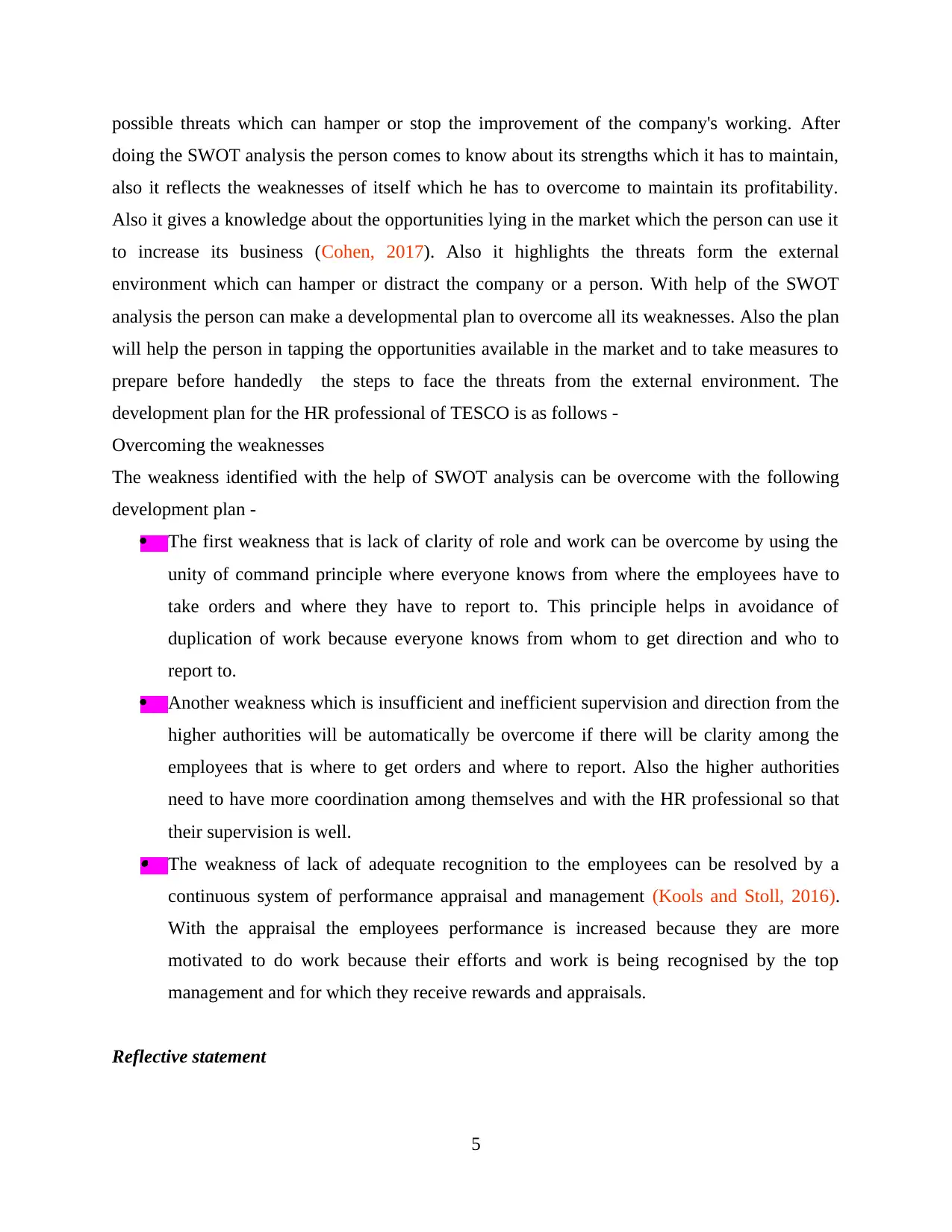
possible threats which can hamper or stop the improvement of the company's working. After
doing the SWOT analysis the person comes to know about its strengths which it has to maintain,
also it reflects the weaknesses of itself which he has to overcome to maintain its profitability.
Also it gives a knowledge about the opportunities lying in the market which the person can use it
to increase its business (Cohen, 2017). Also it highlights the threats form the external
environment which can hamper or distract the company or a person. With help of the SWOT
analysis the person can make a developmental plan to overcome all its weaknesses. Also the plan
will help the person in tapping the opportunities available in the market and to take measures to
prepare before handedly the steps to face the threats from the external environment. The
development plan for the HR professional of TESCO is as follows -
Overcoming the weaknesses
The weakness identified with the help of SWOT analysis can be overcome with the following
development plan -
The first weakness that is lack of clarity of role and work can be overcome by using the
unity of command principle where everyone knows from where the employees have to
take orders and where they have to report to. This principle helps in avoidance of
duplication of work because everyone knows from whom to get direction and who to
report to.
Another weakness which is insufficient and inefficient supervision and direction from the
higher authorities will be automatically be overcome if there will be clarity among the
employees that is where to get orders and where to report. Also the higher authorities
need to have more coordination among themselves and with the HR professional so that
their supervision is well. The weakness of lack of adequate recognition to the employees can be resolved by a
continuous system of performance appraisal and management (Kools and Stoll, 2016).
With the appraisal the employees performance is increased because they are more
motivated to do work because their efforts and work is being recognised by the top
management and for which they receive rewards and appraisals.
Reflective statement
5
doing the SWOT analysis the person comes to know about its strengths which it has to maintain,
also it reflects the weaknesses of itself which he has to overcome to maintain its profitability.
Also it gives a knowledge about the opportunities lying in the market which the person can use it
to increase its business (Cohen, 2017). Also it highlights the threats form the external
environment which can hamper or distract the company or a person. With help of the SWOT
analysis the person can make a developmental plan to overcome all its weaknesses. Also the plan
will help the person in tapping the opportunities available in the market and to take measures to
prepare before handedly the steps to face the threats from the external environment. The
development plan for the HR professional of TESCO is as follows -
Overcoming the weaknesses
The weakness identified with the help of SWOT analysis can be overcome with the following
development plan -
The first weakness that is lack of clarity of role and work can be overcome by using the
unity of command principle where everyone knows from where the employees have to
take orders and where they have to report to. This principle helps in avoidance of
duplication of work because everyone knows from whom to get direction and who to
report to.
Another weakness which is insufficient and inefficient supervision and direction from the
higher authorities will be automatically be overcome if there will be clarity among the
employees that is where to get orders and where to report. Also the higher authorities
need to have more coordination among themselves and with the HR professional so that
their supervision is well. The weakness of lack of adequate recognition to the employees can be resolved by a
continuous system of performance appraisal and management (Kools and Stoll, 2016).
With the appraisal the employees performance is increased because they are more
motivated to do work because their efforts and work is being recognised by the top
management and for which they receive rewards and appraisals.
Reflective statement
5
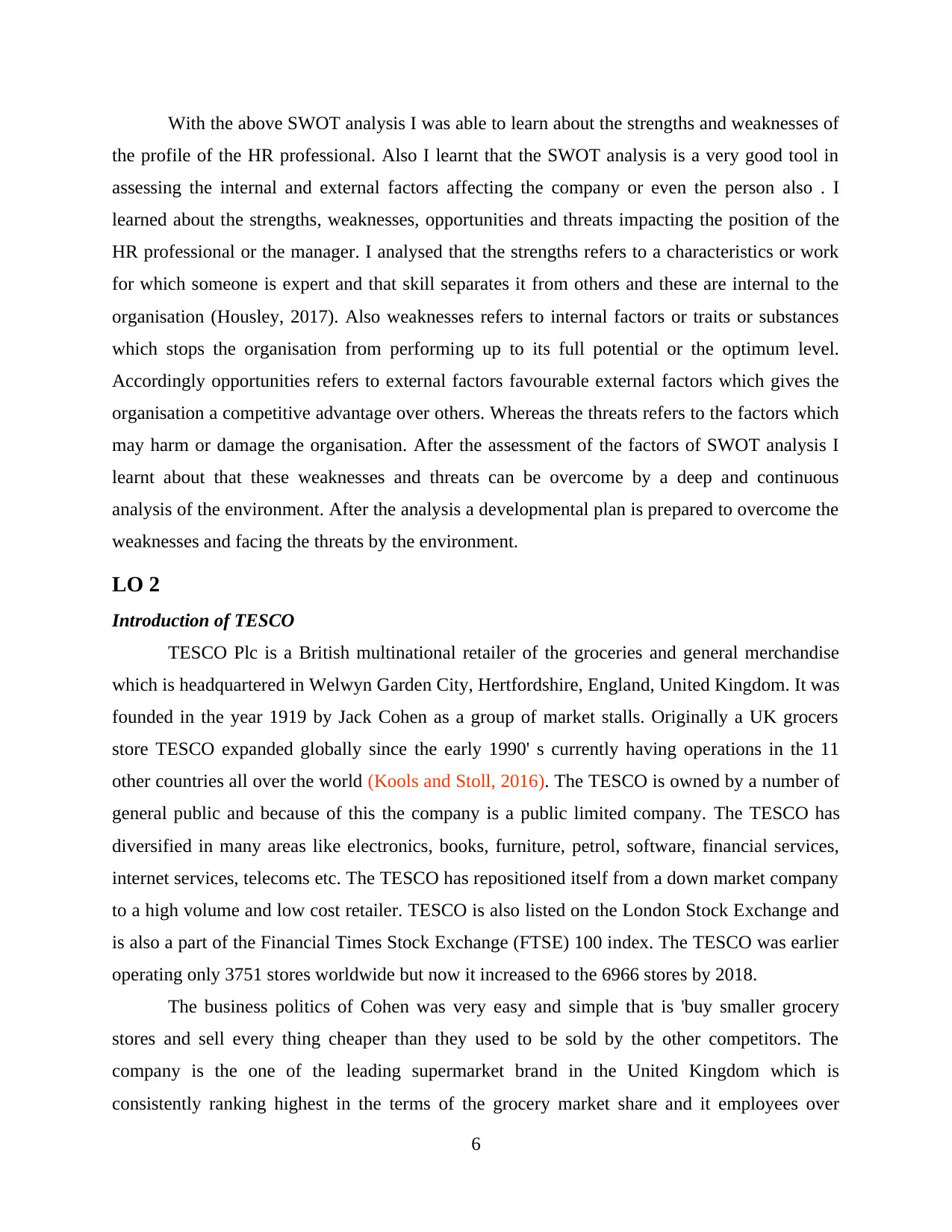
With the above SWOT analysis I was able to learn about the strengths and weaknesses of
the profile of the HR professional. Also I learnt that the SWOT analysis is a very good tool in
assessing the internal and external factors affecting the company or even the person also . I
learned about the strengths, weaknesses, opportunities and threats impacting the position of the
HR professional or the manager. I analysed that the strengths refers to a characteristics or work
for which someone is expert and that skill separates it from others and these are internal to the
organisation (Housley, 2017). Also weaknesses refers to internal factors or traits or substances
which stops the organisation from performing up to its full potential or the optimum level.
Accordingly opportunities refers to external factors favourable external factors which gives the
organisation a competitive advantage over others. Whereas the threats refers to the factors which
may harm or damage the organisation. After the assessment of the factors of SWOT analysis I
learnt about that these weaknesses and threats can be overcome by a deep and continuous
analysis of the environment. After the analysis a developmental plan is prepared to overcome the
weaknesses and facing the threats by the environment.
LO 2
Introduction of TESCO
TESCO Plc is a British multinational retailer of the groceries and general merchandise
which is headquartered in Welwyn Garden City, Hertfordshire, England, United Kingdom. It was
founded in the year 1919 by Jack Cohen as a group of market stalls. Originally a UK grocers
store TESCO expanded globally since the early 1990' s currently having operations in the 11
other countries all over the world (Kools and Stoll, 2016). The TESCO is owned by a number of
general public and because of this the company is a public limited company. The TESCO has
diversified in many areas like electronics, books, furniture, petrol, software, financial services,
internet services, telecoms etc. The TESCO has repositioned itself from a down market company
to a high volume and low cost retailer. TESCO is also listed on the London Stock Exchange and
is also a part of the Financial Times Stock Exchange (FTSE) 100 index. The TESCO was earlier
operating only 3751 stores worldwide but now it increased to the 6966 stores by 2018.
The business politics of Cohen was very easy and simple that is 'buy smaller grocery
stores and sell every thing cheaper than they used to be sold by the other competitors. The
company is the one of the leading supermarket brand in the United Kingdom which is
consistently ranking highest in the terms of the grocery market share and it employees over
6
the profile of the HR professional. Also I learnt that the SWOT analysis is a very good tool in
assessing the internal and external factors affecting the company or even the person also . I
learned about the strengths, weaknesses, opportunities and threats impacting the position of the
HR professional or the manager. I analysed that the strengths refers to a characteristics or work
for which someone is expert and that skill separates it from others and these are internal to the
organisation (Housley, 2017). Also weaknesses refers to internal factors or traits or substances
which stops the organisation from performing up to its full potential or the optimum level.
Accordingly opportunities refers to external factors favourable external factors which gives the
organisation a competitive advantage over others. Whereas the threats refers to the factors which
may harm or damage the organisation. After the assessment of the factors of SWOT analysis I
learnt about that these weaknesses and threats can be overcome by a deep and continuous
analysis of the environment. After the analysis a developmental plan is prepared to overcome the
weaknesses and facing the threats by the environment.
LO 2
Introduction of TESCO
TESCO Plc is a British multinational retailer of the groceries and general merchandise
which is headquartered in Welwyn Garden City, Hertfordshire, England, United Kingdom. It was
founded in the year 1919 by Jack Cohen as a group of market stalls. Originally a UK grocers
store TESCO expanded globally since the early 1990' s currently having operations in the 11
other countries all over the world (Kools and Stoll, 2016). The TESCO is owned by a number of
general public and because of this the company is a public limited company. The TESCO has
diversified in many areas like electronics, books, furniture, petrol, software, financial services,
internet services, telecoms etc. The TESCO has repositioned itself from a down market company
to a high volume and low cost retailer. TESCO is also listed on the London Stock Exchange and
is also a part of the Financial Times Stock Exchange (FTSE) 100 index. The TESCO was earlier
operating only 3751 stores worldwide but now it increased to the 6966 stores by 2018.
The business politics of Cohen was very easy and simple that is 'buy smaller grocery
stores and sell every thing cheaper than they used to be sold by the other competitors. The
company is the one of the leading supermarket brand in the United Kingdom which is
consistently ranking highest in the terms of the grocery market share and it employees over
6
⊘ This is a preview!⊘
Do you want full access?
Subscribe today to unlock all pages.

Trusted by 1+ million students worldwide
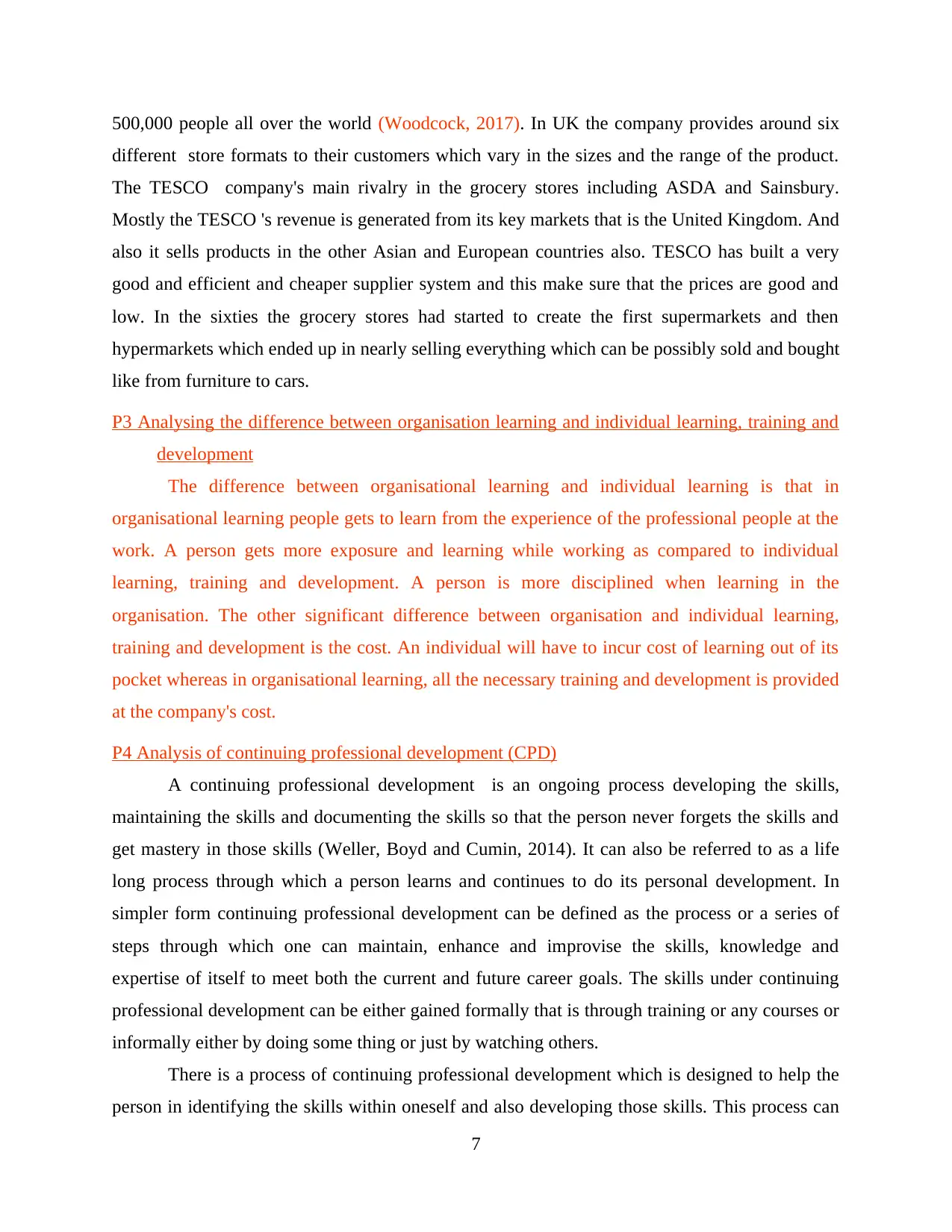
500,000 people all over the world (Woodcock, 2017). In UK the company provides around six
different store formats to their customers which vary in the sizes and the range of the product.
The TESCO company's main rivalry in the grocery stores including ASDA and Sainsbury.
Mostly the TESCO 's revenue is generated from its key markets that is the United Kingdom. And
also it sells products in the other Asian and European countries also. TESCO has built a very
good and efficient and cheaper supplier system and this make sure that the prices are good and
low. In the sixties the grocery stores had started to create the first supermarkets and then
hypermarkets which ended up in nearly selling everything which can be possibly sold and bought
like from furniture to cars.
P3 Analysing the difference between organisation learning and individual learning, training and
development
The difference between organisational learning and individual learning is that in
organisational learning people gets to learn from the experience of the professional people at the
work. A person gets more exposure and learning while working as compared to individual
learning, training and development. A person is more disciplined when learning in the
organisation. The other significant difference between organisation and individual learning,
training and development is the cost. An individual will have to incur cost of learning out of its
pocket whereas in organisational learning, all the necessary training and development is provided
at the company's cost.
P4 Analysis of continuing professional development (CPD)
A continuing professional development is an ongoing process developing the skills,
maintaining the skills and documenting the skills so that the person never forgets the skills and
get mastery in those skills (Weller, Boyd and Cumin, 2014). It can also be referred to as a life
long process through which a person learns and continues to do its personal development. In
simpler form continuing professional development can be defined as the process or a series of
steps through which one can maintain, enhance and improvise the skills, knowledge and
expertise of itself to meet both the current and future career goals. The skills under continuing
professional development can be either gained formally that is through training or any courses or
informally either by doing some thing or just by watching others.
There is a process of continuing professional development which is designed to help the
person in identifying the skills within oneself and also developing those skills. This process can
7
different store formats to their customers which vary in the sizes and the range of the product.
The TESCO company's main rivalry in the grocery stores including ASDA and Sainsbury.
Mostly the TESCO 's revenue is generated from its key markets that is the United Kingdom. And
also it sells products in the other Asian and European countries also. TESCO has built a very
good and efficient and cheaper supplier system and this make sure that the prices are good and
low. In the sixties the grocery stores had started to create the first supermarkets and then
hypermarkets which ended up in nearly selling everything which can be possibly sold and bought
like from furniture to cars.
P3 Analysing the difference between organisation learning and individual learning, training and
development
The difference between organisational learning and individual learning is that in
organisational learning people gets to learn from the experience of the professional people at the
work. A person gets more exposure and learning while working as compared to individual
learning, training and development. A person is more disciplined when learning in the
organisation. The other significant difference between organisation and individual learning,
training and development is the cost. An individual will have to incur cost of learning out of its
pocket whereas in organisational learning, all the necessary training and development is provided
at the company's cost.
P4 Analysis of continuing professional development (CPD)
A continuing professional development is an ongoing process developing the skills,
maintaining the skills and documenting the skills so that the person never forgets the skills and
get mastery in those skills (Weller, Boyd and Cumin, 2014). It can also be referred to as a life
long process through which a person learns and continues to do its personal development. In
simpler form continuing professional development can be defined as the process or a series of
steps through which one can maintain, enhance and improvise the skills, knowledge and
expertise of itself to meet both the current and future career goals. The skills under continuing
professional development can be either gained formally that is through training or any courses or
informally either by doing some thing or just by watching others.
There is a process of continuing professional development which is designed to help the
person in identifying the skills within oneself and also developing those skills. This process can
7
Paraphrase This Document
Need a fresh take? Get an instant paraphrase of this document with our AI Paraphraser
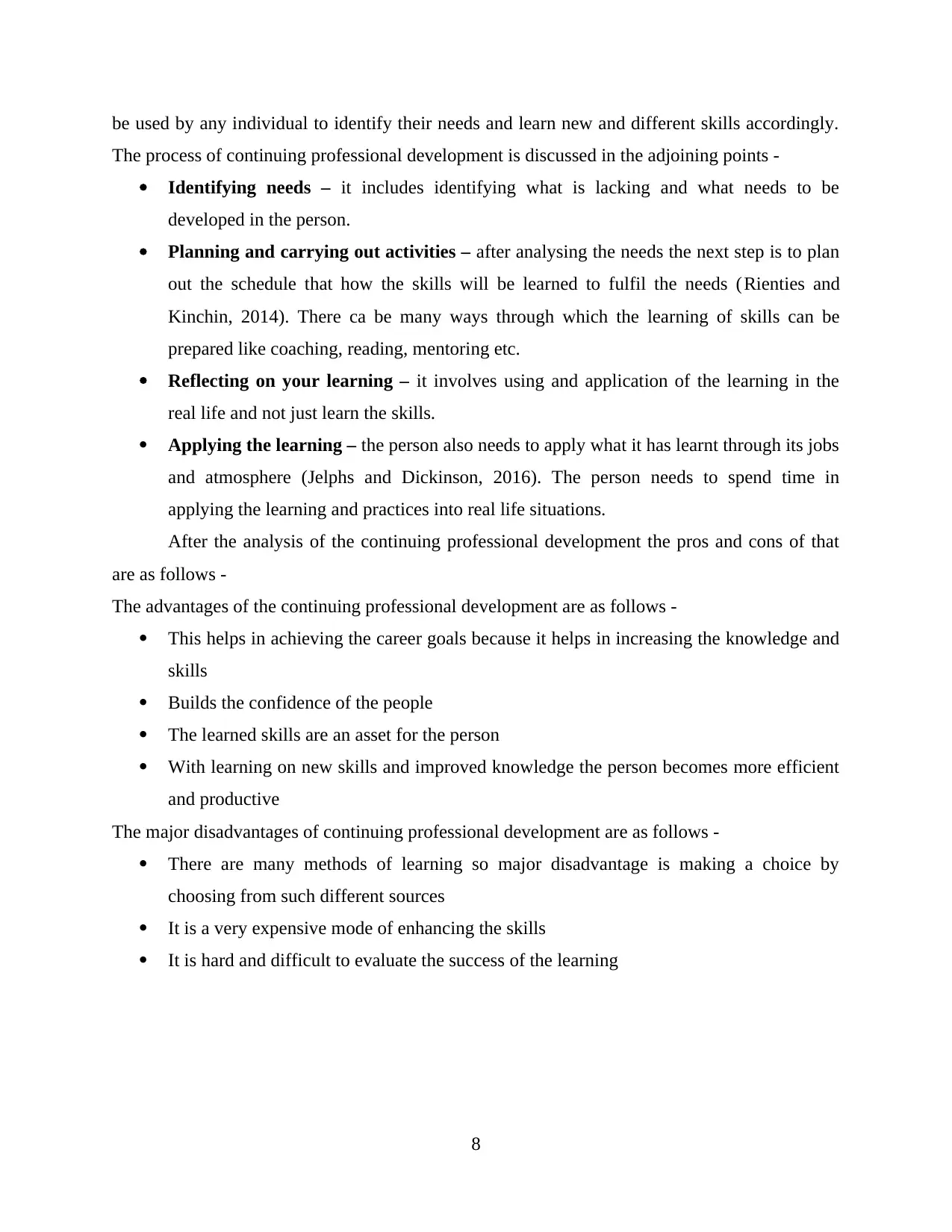
be used by any individual to identify their needs and learn new and different skills accordingly.
The process of continuing professional development is discussed in the adjoining points -
Identifying needs – it includes identifying what is lacking and what needs to be
developed in the person.
Planning and carrying out activities – after analysing the needs the next step is to plan
out the schedule that how the skills will be learned to fulfil the needs (Rienties and
Kinchin, 2014). There ca be many ways through which the learning of skills can be
prepared like coaching, reading, mentoring etc.
Reflecting on your learning – it involves using and application of the learning in the
real life and not just learn the skills.
Applying the learning – the person also needs to apply what it has learnt through its jobs
and atmosphere (Jelphs and Dickinson, 2016). The person needs to spend time in
applying the learning and practices into real life situations.
After the analysis of the continuing professional development the pros and cons of that
are as follows -
The advantages of the continuing professional development are as follows -
This helps in achieving the career goals because it helps in increasing the knowledge and
skills
Builds the confidence of the people
The learned skills are an asset for the person
With learning on new skills and improved knowledge the person becomes more efficient
and productive
The major disadvantages of continuing professional development are as follows -
There are many methods of learning so major disadvantage is making a choice by
choosing from such different sources
It is a very expensive mode of enhancing the skills
It is hard and difficult to evaluate the success of the learning
8
The process of continuing professional development is discussed in the adjoining points -
Identifying needs – it includes identifying what is lacking and what needs to be
developed in the person.
Planning and carrying out activities – after analysing the needs the next step is to plan
out the schedule that how the skills will be learned to fulfil the needs (Rienties and
Kinchin, 2014). There ca be many ways through which the learning of skills can be
prepared like coaching, reading, mentoring etc.
Reflecting on your learning – it involves using and application of the learning in the
real life and not just learn the skills.
Applying the learning – the person also needs to apply what it has learnt through its jobs
and atmosphere (Jelphs and Dickinson, 2016). The person needs to spend time in
applying the learning and practices into real life situations.
After the analysis of the continuing professional development the pros and cons of that
are as follows -
The advantages of the continuing professional development are as follows -
This helps in achieving the career goals because it helps in increasing the knowledge and
skills
Builds the confidence of the people
The learned skills are an asset for the person
With learning on new skills and improved knowledge the person becomes more efficient
and productive
The major disadvantages of continuing professional development are as follows -
There are many methods of learning so major disadvantage is making a choice by
choosing from such different sources
It is a very expensive mode of enhancing the skills
It is hard and difficult to evaluate the success of the learning
8
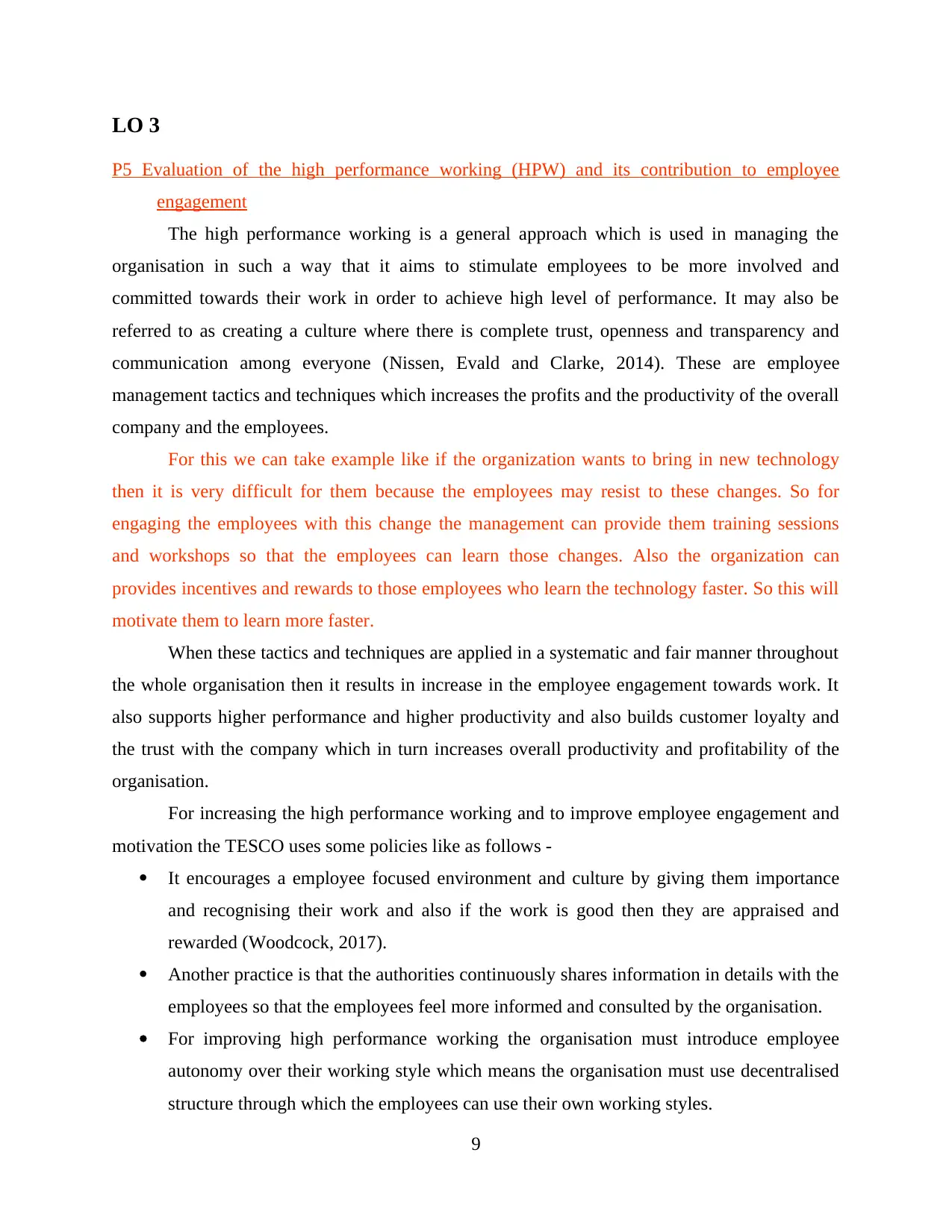
LO 3
P5 Evaluation of the high performance working (HPW) and its contribution to employee
engagement
The high performance working is a general approach which is used in managing the
organisation in such a way that it aims to stimulate employees to be more involved and
committed towards their work in order to achieve high level of performance. It may also be
referred to as creating a culture where there is complete trust, openness and transparency and
communication among everyone (Nissen, Evald and Clarke, 2014). These are employee
management tactics and techniques which increases the profits and the productivity of the overall
company and the employees.
For this we can take example like if the organization wants to bring in new technology
then it is very difficult for them because the employees may resist to these changes. So for
engaging the employees with this change the management can provide them training sessions
and workshops so that the employees can learn those changes. Also the organization can
provides incentives and rewards to those employees who learn the technology faster. So this will
motivate them to learn more faster.
When these tactics and techniques are applied in a systematic and fair manner throughout
the whole organisation then it results in increase in the employee engagement towards work. It
also supports higher performance and higher productivity and also builds customer loyalty and
the trust with the company which in turn increases overall productivity and profitability of the
organisation.
For increasing the high performance working and to improve employee engagement and
motivation the TESCO uses some policies like as follows -
It encourages a employee focused environment and culture by giving them importance
and recognising their work and also if the work is good then they are appraised and
rewarded (Woodcock, 2017).
Another practice is that the authorities continuously shares information in details with the
employees so that the employees feel more informed and consulted by the organisation.
For improving high performance working the organisation must introduce employee
autonomy over their working style which means the organisation must use decentralised
structure through which the employees can use their own working styles.
9
P5 Evaluation of the high performance working (HPW) and its contribution to employee
engagement
The high performance working is a general approach which is used in managing the
organisation in such a way that it aims to stimulate employees to be more involved and
committed towards their work in order to achieve high level of performance. It may also be
referred to as creating a culture where there is complete trust, openness and transparency and
communication among everyone (Nissen, Evald and Clarke, 2014). These are employee
management tactics and techniques which increases the profits and the productivity of the overall
company and the employees.
For this we can take example like if the organization wants to bring in new technology
then it is very difficult for them because the employees may resist to these changes. So for
engaging the employees with this change the management can provide them training sessions
and workshops so that the employees can learn those changes. Also the organization can
provides incentives and rewards to those employees who learn the technology faster. So this will
motivate them to learn more faster.
When these tactics and techniques are applied in a systematic and fair manner throughout
the whole organisation then it results in increase in the employee engagement towards work. It
also supports higher performance and higher productivity and also builds customer loyalty and
the trust with the company which in turn increases overall productivity and profitability of the
organisation.
For increasing the high performance working and to improve employee engagement and
motivation the TESCO uses some policies like as follows -
It encourages a employee focused environment and culture by giving them importance
and recognising their work and also if the work is good then they are appraised and
rewarded (Woodcock, 2017).
Another practice is that the authorities continuously shares information in details with the
employees so that the employees feel more informed and consulted by the organisation.
For improving high performance working the organisation must introduce employee
autonomy over their working style which means the organisation must use decentralised
structure through which the employees can use their own working styles.
9
⊘ This is a preview!⊘
Do you want full access?
Subscribe today to unlock all pages.

Trusted by 1+ million students worldwide
1 out of 16
Related Documents
Your All-in-One AI-Powered Toolkit for Academic Success.
+13062052269
info@desklib.com
Available 24*7 on WhatsApp / Email
![[object Object]](/_next/static/media/star-bottom.7253800d.svg)
Unlock your academic potential
Copyright © 2020–2025 A2Z Services. All Rights Reserved. Developed and managed by ZUCOL.



